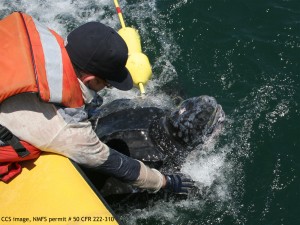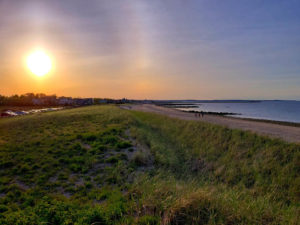Cape Cod is a sandy peninsula created during the ice age that reaches out into the Atlantic Ocean like a crooked arm. Geologists are interested in Cape Cod because it was formed very recently in terms of geologic time and because of the ever-changing shore as the Cape adjusts to the rising sea. Because of its exposed location, many early explorers visited Cape Cod. The Wampanoag people lived here for thousands of years before the Europeans arrived, and were the Cape’s first true settlers.
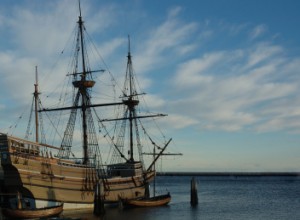 America’s history began along New England’s rugged shores. The Pilgrims first landed in America on the tip of lower Cape Cod. Here they found potable water and food and had their first fight with the natives. The Pilgrims, however, decided that this land was too sandy to support them, and they sailed across Cape Cod Bay to establish Plymouth.
America’s history began along New England’s rugged shores. The Pilgrims first landed in America on the tip of lower Cape Cod. Here they found potable water and food and had their first fight with the natives. The Pilgrims, however, decided that this land was too sandy to support them, and they sailed across Cape Cod Bay to establish Plymouth.
Over the next 20 years settlers spread north and south from Plymouth. The first parts of Cape Cod to be settled were the bay-side sections of Sandwich, Barnstable, and Yarmouth (all incorporated in 1639), along an old Indian trail that is now Route 6A. Most of the newcomers hunted, farmed, and fished; salt hay from the marshes was used to feed cattle and roof houses.
The fortunes of Cape Cod have always been linked to the sea. For centuries fishermen in search of a livelihood, explorers in search of new worlds, and pilgrims of one sort or another in search of a new life – down to the beach-bound tourists of today – all have turned to the waters around Cape Cod. The first homes built by the English settlers on Cape Cod were wigwams built of twigs, bark, hides, cornstalks, and grasses, which they copied from those of the local Wampanoag people.
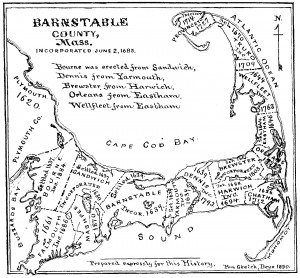 Eventually, the settlers stripped the land of its forests to make farmland, graze sheep, and build more European-style homes, although with a New World look all their own. The steep-roof saltbox and the Cape Cod cottage – still the most popular style of house on the Cape and copied all over the country – were designed to accommodate growing families.
Eventually, the settlers stripped the land of its forests to make farmland, graze sheep, and build more European-style homes, although with a New World look all their own. The steep-roof saltbox and the Cape Cod cottage – still the most popular style of house on the Cape and copied all over the country – were designed to accommodate growing families.
The Wampanoag taught the settlers what they knew of the land and how to live off it. Early on they showed them how to strip and process blubber from the whales that became stranded on the beaches. By the mid-18th century, the supply of near-shore whales thinned out, the decline in whaling hit the economy hard, and the Cape began cultivating tourism in the 19th century. At that time the people traveled from Boston to and along the Cape only by stagecoach or packet boat.
Then in 1848 the first train service from Boston began, reaching to Sandwich; by 1873 it had been extended little by little all the way to Provincetown. The idea of a Cape Cod Canal, linking the bay to the sound, was studied as early as the 17th century, but it was not until 1914 that a privately built canal merged the waters of the two bays. The canal was quite narrow and winding, allowed only one-way traffic, and created dangerous currents. The federal government bought the canal in 1928 and had the U.S. Army Corps of Engineers rebuild it. In the 1930s three bridges – two traffic and one railroad – went up, and the rest is the latter-day history of tourism on Cape Cod.
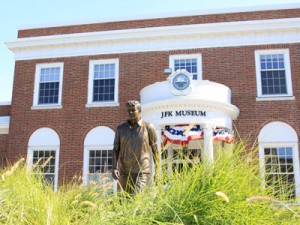 The building of the Mid Cape Highway (U.S. 6) in the 1950s marked the great boom in the Cape’s growth, and the presidency of John F. Kennedy, who summered in Hyannis Port, certainly added to the area’s allure. In 1961 President Kennedy signed the legislation that established the Cape Cod National Seashore. Though tourism, construction, and light industry are the mainstays of the Cape’s economy these days, the earliest inhabitants’ occupations have not disappeared. There are still more than 100 farms on the Cape, and the fishing industry – including lobstering, scalloping, and oyster aquaculture, as well as the fruits of fishing fleets such as those in Provincetown and Chatham bring in over $2 million a month. Travel to one of the nearby islands and see places still steeped in the days of whaling lore, relatively unchanged from over a hundred years ago.
The building of the Mid Cape Highway (U.S. 6) in the 1950s marked the great boom in the Cape’s growth, and the presidency of John F. Kennedy, who summered in Hyannis Port, certainly added to the area’s allure. In 1961 President Kennedy signed the legislation that established the Cape Cod National Seashore. Though tourism, construction, and light industry are the mainstays of the Cape’s economy these days, the earliest inhabitants’ occupations have not disappeared. There are still more than 100 farms on the Cape, and the fishing industry – including lobstering, scalloping, and oyster aquaculture, as well as the fruits of fishing fleets such as those in Provincetown and Chatham bring in over $2 million a month. Travel to one of the nearby islands and see places still steeped in the days of whaling lore, relatively unchanged from over a hundred years ago.
Today, the natural landscape of Cape Cod is little changed. Large areas of forest, dune, beach, and marsh separate small villages. This unspoiled natural beauty makes Cape Cod one of the most favored vacation areas for the people living all over the thickly settled northeastern States.





